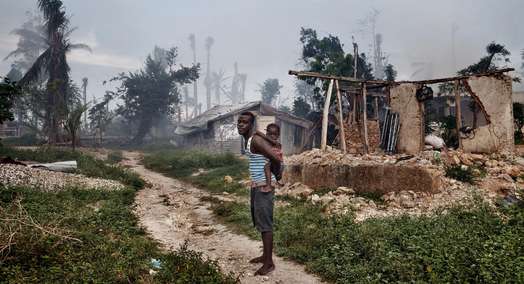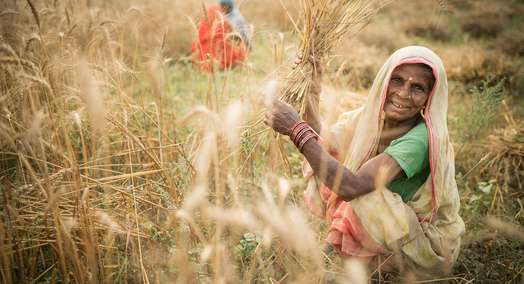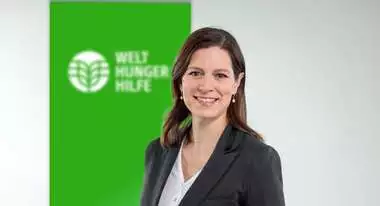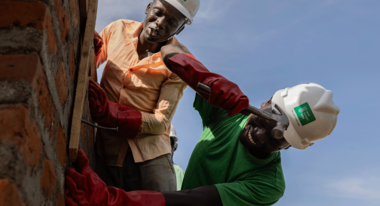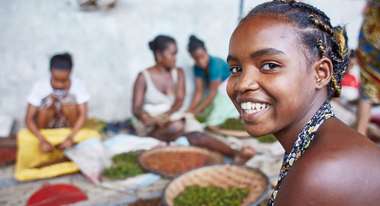Food Right Now - Would You Have Known?
Bits of wisdom to help you become smart
Millennium development goals, development, hunger, wastefulness - we talk about so many things. What do these really mean and what is the significance of such concepts as “the human right to food”? Take part in our little quiz! You just might learn something new.
Can hunger be measured?
Yes! Welthungerhilfe's World Hunger Index allows us to compare the food situation around the globe. This Global Hunger Index includes the number of undernourished people in the overall population, the number of underweight children under the age of five and the mortality rate among children up to five years of age.
The strong points of the Index: The WHI includes the various effects of hunger, the index values give a quick overview and the combination of factors reduces measurement errors.
In our media library you will find teaching material pertaining to the World Hunger Index 2011: "Die Nahrungspreise in den Griff bekommen" [Getting a Grip on Food Prices]. The material is suitable for the upper levels (from classes 11 and up) and for adult education.
Are the Millennium Development Goals really attainable?
Yes, and Welthungerhilfe is starting to produce the evidence! In 2006, the Millennium Villages initiative was begun. The inhabitants of the participating villages in Africa, Asia and Latin America came to an understanding regarding making a tangible contribution for achieving one or more of the millennium development goals.
The fundamental principle is: empowering people to help themselves. Efforts are made to include the entire region in the support of the villages and local partner organisations play an important part.
For the people in the Millennium Villages it is primarily a question of improving their concrete living conditions. Yet empowering people to help themselves involves more than that. In the long term, the inhabitants of the Millennium Villages should be in a position to express their needs, organise themselves and claim their rights.
Who feeds the world?
According to the United Nations' Food and Agriculture Organisation (FAO), approximately 2.6 billion people depend directly on agriculture. 85 per cent of the 525 million farms throughout the world work on less than two hectares of land. Added together, however, this accounts for 60 per cent of the areas under cultivation. According to the Global Report on Agriculture [International Assessment of Agricultural Knowledge, Science and Technology for Development], these small-scale farmers produce the majority of the food.
It is therefore these small farmers or peasants who feed the world. By way of comparison: In 2007, the average German farmer cultivated a good 45 hectares.
How much food is actually being wasted?
One third of the food produced globally - 1.3 billion tons! - spoils either on the way to the consumer or is being wasted. In Africa and Asia, these losses are incurred mainly after the harvest, due to the lack of storage and transport facilities. In the industrialised countries, food that could still be consumed is disposed of for another reason: waste.
Per household and per year we throw out food worth 390 euros. To put it in simplified terms, for every kilo of food, one kilo of the greenhouse gas CO2 is accrued during the production. Anyone wanting to do away with hunger and climate change should buy only what is really needed and maybe occasionally consider eating day-old bread. Some even consider “container diving” or “raiding dumpsters,” in other words, they fish out of the waste containers of supermarkets food that can still be consumed, but where the best-before date has expired.
What is virtual water?
In order to produce foodstuffs, clothing or cars, we need much more water than we think. For example, in your morning coffee, there is 140 litres; in a kilogramme of beef, 15,000 litres; in one single sheet of A4 paper, 10 litres and in one cotton t-shirt, 4100 litres of water!
This is virtual water – this refers to the total amount of water which is contained in a product and which has to be used to produce it. The British geographer, John Anthony Allan, coined the phrase in 1995. Virtual water can, of course, also be found in countless imported products, for example in beans from Egypt, tomatoes from Morocco or oranges from Andalusia. By buying such products, we are importing water from regions which are already suffering from a lack of water, thus we are making the situation even worse.
